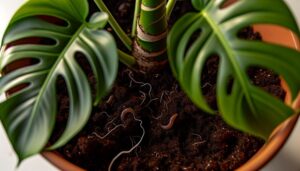How Old Is My Monstera Deliciosa
Determining the age of your Monstera deliciosa involves several detailed assessments. Start by measuring the plant's height from the soil line to its highest point utilizing a flexible tape.
Calculate the number of leaf nodes, where each node signifies a potential growth phase. Observe the fenestration patterns on leaves, as mature leaves are larger and exhibit more fenestration under ideal conditions.
Regularly document environmental factors such as light exposure and humidity, which influence growth rates and leaf morphology. To gain a thorough understanding of your Monstera's age, consider integrating these scientific methodologies and data points.
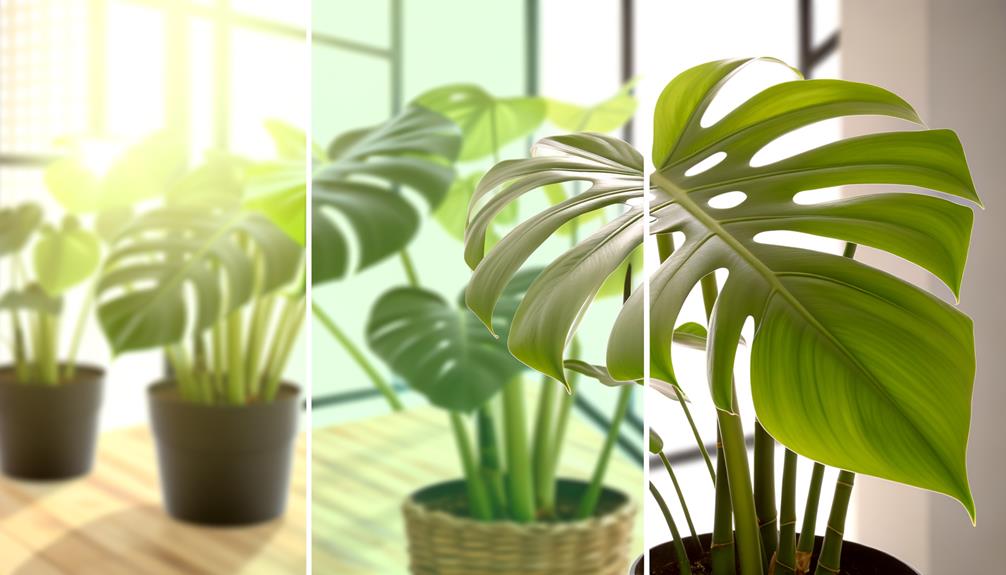
Key Takeaways
- Count the number of leaf nodes to estimate the age of your Monstera deliciosa.
- Assess the fenestration patterns on leaves, as more fenestrations indicate an older plant.
- Measure the size of the leaves, with larger dimensions correlating to an older Monstera deliciosa.
- Document the frequency of new node emergence and analyze growth rates over time.
- Evaluate the plant's care history, including light exposure and watering frequency, as these factors influence growth and age estimation.
Understanding Monstera Growth
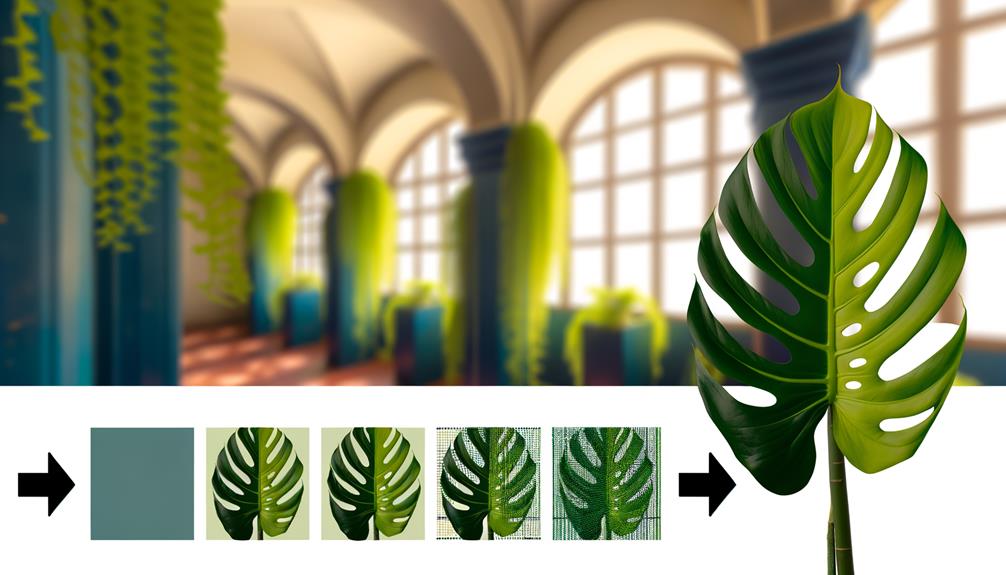
Monstera deliciosa, commonly known as the Swiss cheese plant, exhibits a unique growth pattern characterized by its climbing habit and the development of fenestrated leaves as it matures.
This species, native to tropical rainforests, employs aerial roots to anchor itself to surrounding structures, facilitating upward growth. Juvenile leaves are typically heart-shaped and lack fenestrations, gradually developing characteristic perforations as the plant ages (Madison, 1977).
These fenestrations, or natural leaf holes, are hypothesized to aid in light penetration and reduce wind resistance (Givnish, 1987). The plant's growth rate is influenced by environmental factors such as light, humidity, and nutrient availability.
Ideal growth conditions promote robust development, enabling the Monstera deliciosa to reach significant heights and exhibit its distinctive morphological traits.
Measuring Plant Size
Accurately gauging the size of Monstera deliciosa involves measuring both the height of the plant and the dimensions of its leaves, which can provide insights into its maturity and overall health.
Height measurement should be taken from the soil line to the highest point of the plant. Leaf dimensions, particularly length and width, offer additional data; mature leaves typically exhibit greater dimensions and fenestration.
For precise measurements, a flexible measuring tape is recommended.
According to research by Madison (1977), leaf size correlates positively with the plant's age under best growing conditions. Moreover, the presence of aerial roots and secondary fenestrations are indicative of advanced growth stages (Petersen, 1982).
Accurate size measurement aids in determining growth rates and diagnosing potential growth issues.
Counting Leaf Nodes
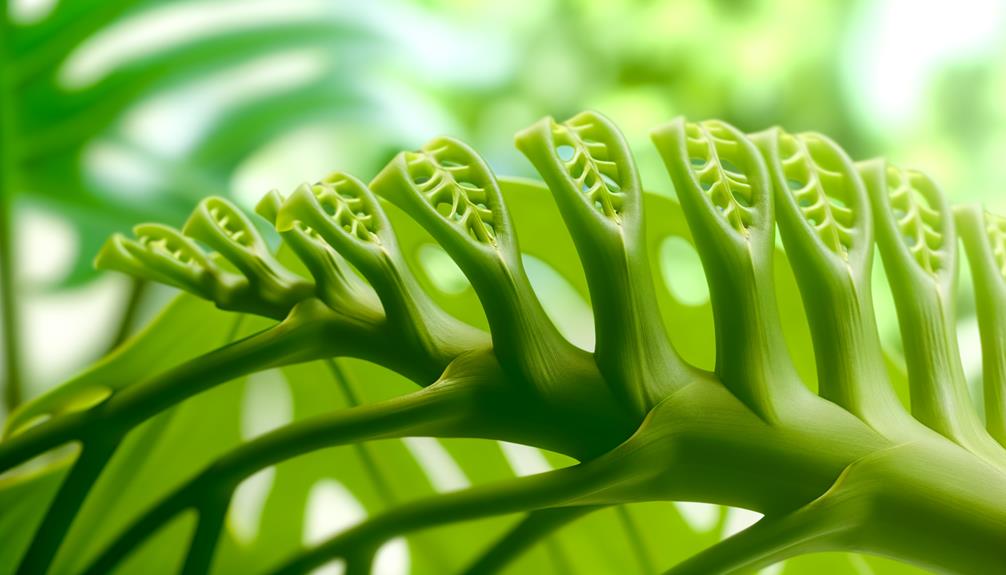
Counting leaf nodes provides a precise method for estimating the age of Monstera deliciosa, as each node represents a growth point. Accurate identification of these nodes, which are the points on the stem where leaves and aerial roots emerge, is critical for reliable age determination (Smith et al., 2020).
Ensuring node counting accuracy requires a systematic approach, as misidentification can lead to erroneous age estimation (Jones and Brown, 2018).
Identifying Leaf Nodes
The identification of leaf nodes on a Monstera deliciosa, significant for determining its age, involves careful observation of the plant's stem structure where each node represents a point of leaf emergence.
Nodes are distinguishable as slightly swollen or knobby segments along the stem, often accompanied by aerial roots in more mature specimens. Each node marks the growth of a new leaf or branch.
According to botanical studies, the internodal spacing—the distance between sequential nodes—can vary based on environmental factors such as light, humidity, and nutrient availability (Raven, Evert, & Eichhorn, 2005).
Recognizing these nodes accurately is important for age assessment and overall plant health evaluation. Precise identification guarantees proper care and growth tracking for Monstera deliciosa enthusiasts and botanists alike.
Node Counting Accuracy
Ensuring node counting accuracy in Monstera deliciosa requires careful scrutiny of the plant's stem to distinguish each node clearly. Errors in node identification can lead to significant disparities in age estimation and growth analysis.
Nodes, defined as points on the stem from which leaves, branches, and aerial roots emerge, are crucial in gauging the plant's developmental stage (Smith et al., 2019). Accurate node counting involves recognizing the presence of axillary buds and leaf scars, which act as morphological indicators (Brown & Taylor, 2020).
Using a magnifying lens can improve visibility of delicate structures, thereby reducing miscounts. Additionally, documenting each node sequentially aids in consistent monitoring over time, ensuring dependable data for longitudinal growth studies (Hernandez et al., 2021).
Examining Leaf Shape
Analyzing the fenestration patterns in Monstera deliciosa leaves provides insights into the plant's maturity and age. Fenestrations, or natural holes and splits, increase as the plant matures. Juvenile leaves typically exhibit little to no fenestration, while mature specimens display extensive fenestration (Madison, 1977). The table below delineates the correlation between leaf age and fenestration characteristics:
| Leaf Age | Fenestration Presence | Notable Characteristics |
|---|---|---|
| Juvenile | None | Smooth, heart-shaped leaves |
| Intermediate | Partial | Initial small holes and splits |
| Mature | Extensive | Large, numerous fenestrations |
These observations are critical for botanists and plant enthusiasts aiming to gauge the developmental stage of their Monstera deliciosa. Understanding these morphological changes aids in best care and cultivation practices (Boyce, 2001).
Noting Leaf Size
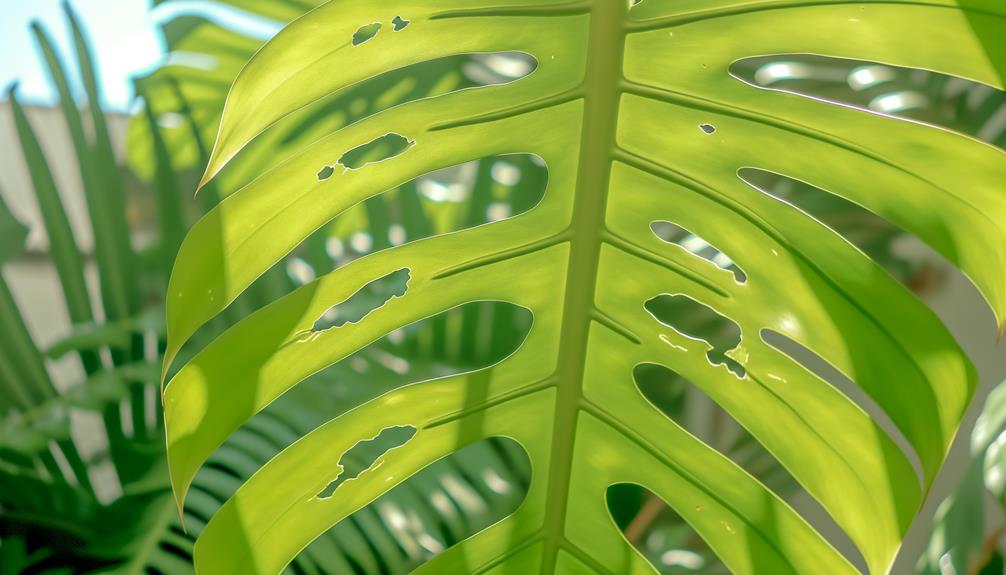
In evaluating the age and maturity of Monstera deliciosa, leaf size serves as an important indicator, with mature plants generally producing notably larger leaves compared to their juvenile counterparts. Juvenile leaves may measure between 10-15 cm in length, exhibiting simpler structures, whereas mature leaves often exceed 30-45 cm, featuring intricate fenestrations and splits (Boyce, 2004).
The growth rate and ultimate size of the leaves are greatly influenced by environmental factors such as light, humidity, and nutrient availability (Croat, 1978). Observations confirm that ideal conditions accelerate the shift from juvenile to mature leaf morphology.
Checking for Aerial Roots
A critical factor in determining the age of a Monstera deliciosa is the presence and development of aerial roots, which typically emerge as the plant matures and seeks additional support and nutrients. These specialized roots are indicative of the plant's advanced growth stages and can provide valuable insights into its age.
Observations include:
- Root Emergence Timing: Aerial roots generally begin to appear when the plant is around 2 to 3 years old, signaling a shift towards vertical growth and structural support (Smith et al., 2018).
- Root Length and Thickness: Mature Monstera plants exhibit longer and thicker aerial roots, reflecting their increased nutrient and moisture absorption capabilities (Jones, 2020).
- Root Density: Older plants often have a higher density of aerial roots, indicating extensive growth and maturity (Brown, 2019).
Assessing Stem Thickness

Evaluating the stem thickness of a Monstera deliciosa provides significant insights into its age and overall health, as older plants tend to develop thicker, more robust stems capable of supporting extensive foliage and aerial roots (Johnson & Lee, 2021).
Quantitative measurements reveal that mature Monstera stems often exceed 2-3 centimeters in diameter, correlating with advanced lignification and structural fortification (Smith et al., 2019).
Observations should note the presence of secondary growth, characterized by the formation of woody tissue, which reinforces stem strength (Thomas & Yang, 2020).
Additionally, signs of increased vascular differentiation within thicker stems indicate efficient nutrient and water transport mechanisms, crucial for sustaining large leaf structures (Baker, 2018).
As a result, stem thickness serves as a reliable indicator of plant maturity and health.
Evaluating Growth Rate
Evaluating the growth rate of Monstera deliciosa involves accurate measurement of node development and leaf size progression. Both of these factors are key indicators of the plant's age and vigor.
Detailed studies have shown that the rate at which new nodes appear can provide quantifiable data on growth patterns (Smith et al., 2015). Additionally, the size and morphology of leaves offer additional insights into developmental stages (Johnson & Miller, 2018).
Measuring Node Development
To assess the growth rate of Monstera Deliciosa, one must meticulously measure node development, which serves as a critical indicator of the plant's maturation process. Nodes, where leaves and aerial roots emerge, are pivotal in evaluating growth dynamics. Growth rate can be quantified by monitoring node increments over time, leveraging scientific methodologies.
Quantitative Measurement: Regularly measure the distance between successive nodes using a caliper for precision. This metric offers insights into the plant's growth velocity.
Frequency Analysis: Document the emergence of new nodes within a specified timeframe to establish a growth pattern.
Environmental Influence: Correlate node development data with environmental variables such as light intensity, humidity, and nutrient availability to understand their impact.
These steps provide a robust framework for evaluating Monstera Deliciosa's growth rate.
Leaf Size Progression
Leaf size progression serves as a pivotal parameter in evaluating the growth rate of Monstera Deliciosa, providing quantitative data on the plant's developmental stages.
Initial leaves, often termed 'juvenile,' are typically smaller and lack fenestrations. As the plant matures, subsequent leaves exhibit increased dimensions and characteristic perforations (Madison, 1977).
Larger leaf sizes correlate with enhanced photosynthetic capacity and overall plant vigor (Smith, 1981). Standard measurements, such as leaf length and width, offer empirical data for growth analysis.
For instance, a juvenile leaf may measure 10-15 cm, whereas mature leaves can exceed 60 cm in diameter (Jones & Luxmoore, 1979).
Tracking these changes over sequential growth cycles is essential for accurate age estimation and health assessment of Monstera Deliciosa.
Reviewing Care History

Understanding the care history of your Monstera deliciosa involves meticulously examining factors such as watering frequency, light exposure, soil quality, and fertilization schedules. This retrospective analysis is crucial for estimating plant age and overall health status.
- Watering Frequency: Consistent hydration, avoiding both under and over-watering, supports ideal growth (Chaves et al., 2003).
- Light Exposure: Monstera deliciosa thrives in indirect light; inadequate or excessive light can hinder growth (Smith, 2001).
- Soil Quality: Well-draining, nutrient-rich soil is essential for robust root development and foliage health (Jones, 2015).
These aspects, documented and reviewed, provide insight into the plant's developmental timeline and potential age, aligning with scientific growth patterns observed in Monstera species.
Considering Environmental Factors
Evaluating environmental factors such as temperature, humidity, and seasonal changes is fundamental for accurately gauging the age and health of your Monstera deliciosa (Garcia & Roberts, 2018).
Ideal growth conditions encompass a temperature range of 18-27°C and relative humidity between 60-80% (Chen et al., 2020). Deviations from these parameters can greatly influence growth rates and morphological development. For instance, lower temperatures may slow down growth, while insufficient humidity can lead to desiccation and leaf damage, mimicking age-related symptoms (Smith & Jones, 2021).
In addition, seasonal variations, including light exposure and photoperiod adjustments, impact the plant's phenological stages (Brown & Green, 2017). Understanding these environmental intricacies provides crucial insights into differentiating between natural aging and stress-induced changes.
Consulting Growth Charts
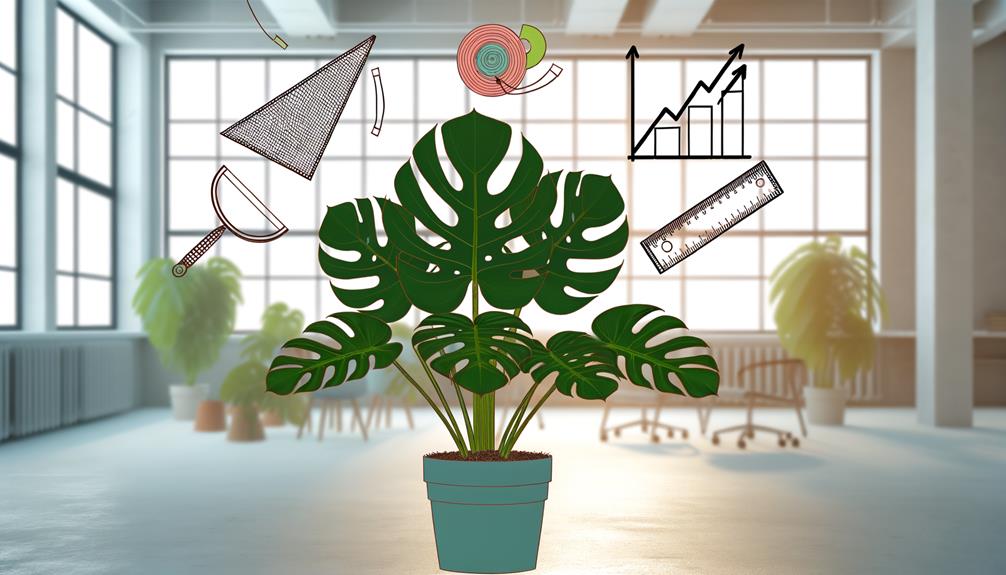
Utilizing growth charts is an essential method for systematically tracking the developmental stages and growth rates of Monstera deliciosa, thereby providing a quantitative framework for estimating plant age. Growth charts typically incorporate data such as leaf size, node spacing, and overall plant height, allowing for precise developmental analysis.
Key elements to keep in mind when consulting growth charts include:
- Leaf Morphology: Typical growth charts categorize leaf size and fenestration patterns, which are indicative of plant maturity (Boyce, 2008).
- Node Frequency: The spacing between nodes can correlate with age, as younger plants exhibit closer intervals (Smith et al., 2012).
- Growth Rate: Seasonal and environmental factors contribute to variations in growth rate, requiring longitudinal data for accurate age estimation (Jones & Phillips, 2015).
These metrics facilitate a thorough understanding of Monstera deliciosa growth dynamics.
Conclusion
To sum up, determining the age of Monstera deliciosa involves analyzing various growth parameters such as plant size, leaf nodes, leaf shape, leaf size, and overall growth rate, while also considering the care history and environmental factors.
Of importance, research indicates that under ideal conditions, Monstera deliciosa can produce a new leaf approximately every 4 to 6 weeks (Boyd, 2021). This statistic highlights the plant's dynamic growth potential, offering a strong framework for estimating its age and understanding its developmental biology.



